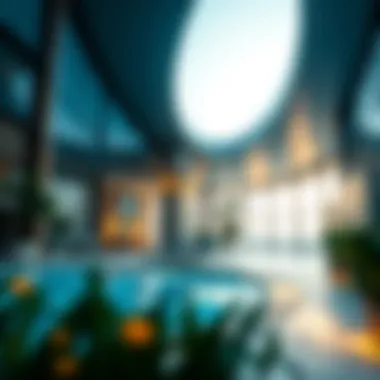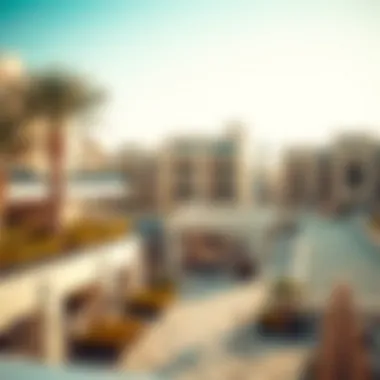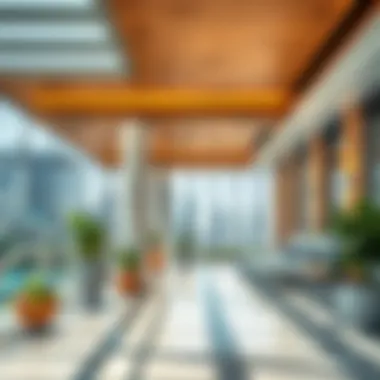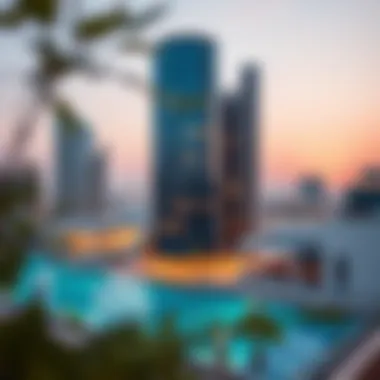Understanding Solarium Buildings in Dubai's Real Estate


Intro
In the ever-evolving landscape of Dubai's real estate, solarium buildings have emerged as a notable feature, blending cutting-edge design with functionality. In simple terms, solarium buildings incorporate a significant amount of glazing and natural light, contributing to enhanced living spaces while promoting sustainability. As urban development in Dubai pushes boundaries, understanding the significance and emerging trends surrounding solarium structures is crucial for investors, homeowners, and real estate professionals alike. This article delves into the multifaceted dimensions of solarium buildings, shedding light on their architectural relevance, market dynamics, and the diverse advantages they offer.
By exploring how these innovative structures fit within community planning and lifestyle enhancement, we aim to equip readers with insights necessary to navigate this niche in the property market successfully. Let's kick off this exploration with some key points related to market insights.
Prolusion to Solarium Buildings
Solarium buildings have carved out a unique niche within the bustling Dubai real estate market. More than mere architectural whims, these structures hold significant value due to their innovative designs and multifaceted benefits. Understanding solarium buildings is essential not only for investors but also for homeowners and developers aiming to capitalize on current trends in the real estate landscape.
Definition and Concept
At its core, a solarium is a space designed to admit natural light, encouraging a seamless blend of indoor and outdoor environments. Often featuring expansive glass panels, solarium buildings invite sunlight to bathe interiors, creating warm and inviting atmospheres. This concept transcends the mere aesthetic; it embodies notions of sustainability and energy efficiency. In a sunny locale like Dubai, such features resonate profoundly with current lifestyle demands, promoting well-being through a greater connection with the outdoors.
Historical Background
The roots of solarium buildings can be traced back to the late 19th century, when they emerged as innovative solutions for enhancing natural light in homes. However, it wasn’t until the late 20th century that this trend began to gain traction in urban environments, particularly in eco-conscious locales. In Dubai, the evolution of this architectural style coincided with the city's rapid development and transformation into a global hub of luxury and modernity. The integration of modern technologies into these structures has only increased their popularity in recent years. This marriage of tradition and innovation illustrates how solarium buildings reflect the growing appreciation for natural light and breezes, allowing designers and architects to develop spaces that are both practical and visually striking.
"A solarium isn’t just about letting light in; it’s about inviting life into a space, creating a connection with the outside world."
In essence, as we delve deeper into this exploration of solarium buildings in Dubai, the interplay of design, functionality, and environmental concerns will become increasingly clearer. This topic promises to unearth essential understandings for various stakeholders navigating this evolving market.
Architectural Features of Solarium Buildings
The architectural features of solarium buildings play a vital role in their functionality and appeal, especially in the diverse urban landscape of Dubai. These structures are designed not just for aesthetics but also target practical benefits, promoting a lifestyle that embraces natural light and sustainable living. As cities evolve, the way architecture interacts with environmental factors becomes increasingly relevant. Solarium buildings stand as a prime example of how innovative design can lead to new standards in urban development.
Design Elements
Materials
The choice of materials in solarium construction can significantly influence both the structural integrity and the ambiance of the building. Commonly used materials like glass and aluminum are not just popular for their lightweight characteristics but also for their ability to facilitate natural lighting. Glass, specifically, offers an unobstructed view of the stunning skyline of Dubai while allowing sunlight to penetrate deeply into the living spaces. However, durability is a key characteristic; materials must withstand Dubai’s harsh climate—prolonged heat and occasional sandstorms. Investing in tempered or double-glazed glass can mitigate issues related to thermal expansion and maintain a comfortable indoor environment.
- Key characteristics of Materials:
- Lightweight yet durable: Important for high-rise construction.
- Thermal Insulation: Glass treatments enhance energy efficiency.
- Aesthetic Flexibility: Allows for innovative designs that can appeal to high-end buyers.
The unique feature of these materials, especially glass, is that it can be treated or tinted to reduce glare or improve energy efficiency, making it a flexible option. However, challenges remain—high costs for high-quality options and potential issues with heat accumulation can deter some developers. Yet, for many, the benefits far outweigh the drawbacks, making glass and other modern materials the go-to choices for solarium buildings in Dubai.
Structural Innovations
Structural innovations in solarium buildings contribute substantially to redefining urban architecture. Advanced framing techniques, including glass facades and cantilevered structures, allow for more expansive open spaces and an enhanced connection with the outdoors. Innovations such as these enable architects to push the boundaries of traditional design, making buildings not just places to live but spaces that integrate with nature and the urban environment.
- Key characteristics of Structural Innovations:
- Sustainability: Reducing resource consumption with improved materials and designs.
- Efficiency: Meeting stringent building codes while maximizing living space.
- Safety and Resilience: Implementing designs that can withstand natural forces.
One significant feature is the integration of smart technology within structural design, such as automated shading systems that adjust based on sunlight, which leads to reduced energy costs. Though these innovations can come at a premium during construction, they result in long-term savings, justifying their inclusion in luxury real estate.
Aesthetic Appeal


The aesthetic appeal of solarium buildings drastically enhances their marketability. A well-designed solarium can create harmonious living spaces that captivate potential buyers and renters. With sweeping views of the city and a flood of natural light, these buildings often command a premium. Furthermore, the potential for customization allows architects and homeowners to create unique styles that reflect personal tastes while still adhering to a cohesive urban plan. This blend of individuality and conformity can be seen as a driving factor in the increasing popularity of solarium designs in Dubai.
Integration with Surroundings
Integration with surrounding environments is another critical aspect of solarium architecture. The goal is not to create isolated structures but to foster a sense of community within urban settings. Solarium buildings are often positioned to enhance the overall aesthetic of neighborhoods, with thoughtful landscaping, shared public spaces, and proximity to amenities. By incorporating local architecture styles and sustainable landscaping into their designs, developers can ensure that solarium buildings not only stand out but also complement the existing urban fabric. This is essential in maintaining the harmony between nature and the built environment, ensuring that these iconic structures contribute positively to the cityscape of Dubai.
"The future of architectural design lies not just in individual buildings but in how they interact with their surroundings to create a cohesive living experience."
Addressing these architectural features holistically allows developers and architects to create meaningful spaces that resonate with the needs of modern urban populations, making solarium buildings an integral part of Dubai's real estate landscape.
Practical Benefits of Solarium Buildings
The appeal of solarium buildings goes beyond their eye-catching architecture; they provide real, tangible benefits that are especially pertinent in the context of Dubai’s evolving real estate market. With the increasing emphasis on sustainability and quality of life, understanding these benefits can be invaluable for stakeholders ranging from investors to residents.
Enhanced Natural Lighting
One of the most significant advantages of solarium buildings is the abundance of natural light they provide. This influx of sunlight not only creates a vibrant and inviting atmosphere but also positively impacts the mood and productivity of those who inhabit these spaces. Natural light is known to enhance well-being, helping to regulate circadian rhythms and reduce the reliance on artificial lighting throughout the day.
More importantly, with the blazing sun common in Dubai, buildings designed to maximize sunlight come with their own set of considerations. Careful orientation is crucial; well-positioned solarium windows allow light to flood in during the day but minimize harsh glare, creating a balanced and comfortable indoor environment. The bright interiors can improve the visual aesthetics of properties, making them more appealing to potential buyers or tenants.
Energy Efficiency
Passive Solar Heating
Passive solar heating is another crowning benefit of solarium buildings, particularly in the climate of Dubai. By cleverly utilizing materials and the sun's natural energy, these structures can significantly reduce heating requirements in cooler months. This technique doesn’t need complex mechanical systems. Instead, the design features, such as large south-facing windows, thermal mass walls, and strategic shading, work together to collect and store heat from the sun.
This approach not only lowers energy consumption but also cuts down on carbon footprints—an increasingly important factor for eco-conscious developers and buyers. The charm of passive solar heating is its low-maintenance nature as it does not require any significant operational costs once constructed.
Reduced Energy Costs
With energy prices on the rise, reduced energy costs can be a game changer. Solarium buildings often feature improved insulation and energy-efficient designs which help mitigate energy bills. By harnessing sunlight effectively, homeowners and tenants can enjoy a more comfortable living environment while spending less on utilities.
A unique characteristic of having reduced energy costs in solarium structures stems from their capability of minimizing dependence on conventional heating and cooling systems. This not only translates into monetary savings but also contributes to a larger goal of sustainability. Such benefits can ultimately enhance property value, making solarium buildings an attractive investment more than ever in the competitive Dubai real estate market.
Health and Well-Being
In addition to energy savings, solarium buildings promote overall health and well-being. Exposure to natural light is linked to improved mental health, reducing stress and anxiety levels. Furthermore, these environments can encourage a more active lifestyle. The design of solarium structures often integrates gardens and green spaces, fostering outdoor activities and a connection with nature—elements famed for boosting psychological health.
It’s clear that solarium buildings are more than just trendy additions to Dubai’s skyline. Their thoughtful integration of natural lighting, energy efficiency, and health benefits serves several facets of urban living. As stakeholders dive into the intricacies of the real estate landscape, recognizing these advantages can aid in not just making informed decisions but crafting healthier communities for residents.
Market Trends in Solarium Development
The real estate landscape in Dubai is constantly evolving, and the emergence of solarium buildings is at the forefront of this transformation. These structures, characterized by their large, glass-enclosed spaces, cater to a growing demand for homes that prioritize natural light and energy efficiency. Delving into the market trends associated with solarium development reveals critical insights for investors, developers, and homebuyers alike.
Current Demand Analysis
The appetite for solarium buildings in Dubai stems from several societal shifts. As urban living becomes more prevalent, potential homeowners are increasingly seeking dwellings that blend both comfort and sustainability. The demand has surged, particularly among environmentally conscious buyers who appreciate the benefits of solar energy and passive heating.
Key factors influencing current demand include:
- Climate: The hot desert conditions in Dubai make thermal comfort essential. Solarium structures help maintain pleasant indoor environments without excessive reliance on air conditioning.
- Health Trends: There's an increasing awareness of wellness, driving interest in properties that allow natural light to flood living spaces, promoting better moods and productivity.
- Aesthetic Appeal: Buyers are drawn to the modern designs of solarium buildings that bring an outdoor feel into urban settings.


"Buying a home is no longer just about the four walls and a roof; it’s about a lifestyle that values well-being and connection to nature."
Investment Potential
Investing in solarium buildings is proving to be a financially savvy decision. As Dubai positions itself as a global hub for innovation and technology, homes that emphasize sustainability and modern aesthetics are likely to hold their values over time.
Investors should consider the following points:
- Rising Property Value: As the demand for eco-friendly living spaces escalates, properties that integrate solar technology find themselves in high demand, leading to value appreciation.
- Tenant Attraction: Rental properties that feature solarium designs typically attract higher-caliber tenants, reducing vacancy rates and ensuring steady cash flow.
- Government Incentives: Local policies encouraging sustainable construction practices often come with financial incentives, making the investment in solarium buildings not just ethical but also economically advantageous.
Buyer Preferences
Understanding buyer preferences in the realm of solarium structures is essential for developers aiming to capture this burgeoning market. Potential homeowners are well-informed and discerning about their choices.
Notable preferences include:
- Energy-Efficient Features: Buyers prefer homes that reduce utility costs. This includes integrated solar panels and energy-efficient windows.
- Versatile Spaces: Families appreciate adaptable space for various activities, thus floor plans that allow for multi-functional rooms within solariums are favored.
- Community Amenities: Buyers are now looking at more than just the property. Proximity to parks, schools, and community centers enhances the value of living in a solarium building.
Environmental Implications of Solarium Structures
The environmental implications of solarium buildings play a critical role in understanding their significance within Dubai's evolving real estate scene. As urban areas grapple with increasing population density and the corresponding effects on ecosystem stability, solarium structures offer a promising approach to mitigating various environmental issues. Their distinct features help to address concerns on sustainability, urban heat, and the overall impact on city living.
Sustainable Building Practices
Implementing sustainable building practices is at the heart of solarium construction. These structures typically prioritize eco-friendly materials and innovative design, creating habitats that harmonize with their surroundings. The integration of natural light, through extensive glass features, not only enhances aesthetic value but also reduces reliance on artificial lighting, contributing to energy efficiency.
- Eco-friendly Materials: Common materials used in solarium buildings include recycled metals and sustainably sourced wood. These choices minimize the carbon footprint and bolster the reputation of developers committed to green building practices.
- Energy-Efficient Design: Solariums often incorporate passive solar heating systems, which harness the sun's energy, thereby reducing heating costs during the cooler months.
- Rainwater Harvesting: Some solarium buildings are designed to capture and utilize rainwater, contributing to water conservation efforts in arid climates like Dubai's.
Thus, sustainable building practices in solarium development are multifaceted, making them a viable option for environmentally conscious investors and homeowners alike.
Urban Heat Island Effect Mitigation
Urban heat islands (UHIs) are a well-documented phenomenon in sprawling metropolitan areas. They occur when cities create islands of heat due to concrete, asphalt, and limited greenery. Solarium buildings, with their unique structure and design, offer effective solutions to mitigate this effect.
- Greening Up Urban Spaces: Many solarium buildings integrate vertical gardens and outdoor living spaces, which contribute to increased greenery in urban settings, effectively reducing ambient temperatures. This greenery not only cools the air but also enhances urban biodiversity.
- Reflective Surfaces: The use of reflective glazing in solarium windows can play a critical role in minimizing heat absorption. This feature directly counters the warming effects of sunlight, helping to maintain cooler surroundings.
- Natural Ventilation: Design elements that promote airflow can reduce the need for air conditioning, further decreasing energy usage and combatting the heat generated through urbanization.
As cities embrace solarium architecture, they may witness a tangible reduction in urban temperatures, benefiting both residents and the environment.
By examining the sustainable building practices and approaches to mitigating the urban heat island effect, it becomes clear that solarium structures are not just a stylish feature in Dubai's skyline. They represent a forward-thinking solution to some of the pressing environmental challenges facing modern cities. Investors and homeowners alike should consider the broader benefits of these developments as they make decisions on future investments in real estate.
Challenges in Building Solarium Structures
Building solarium structures comes with its share of trials. Although these innovative spaces offer numerous benefits, addressing specific challenges is critical to ensure their successful integration into Dubai’s unique skyline and lifestyle. Here, we delve into the primary hurdles, including regulatory constraints, construction costs, and ongoing maintenance issues.
Regulatory Hurdles
Regulatory challenges can be a real thorn in the side for developers aiming to build solarium structures. In Dubai, where urban planning is meticulously controlled, compliance with local laws is non-negotiable. Developers must navigate a labyrinth of regulations concerning zoning, building codes, and environmental impact assessments before they can even set foot on a construction site. The Dubai Municipality has established guidelines that dictate everything from the materials used to the height of buildings. Failure to adhere can lead to costly delays or, worse, project cancellations.
Additionally, obtaining the necessary permits can be time-consuming and complex. Developers often find themselves in lengthy discussions with different authorities, needing to showcase how solarium designs fit into the broader vision for urban development. This challenge is not limited to architectural compliance alone, as there are also environmental regulations aimed at curbing carbon footprints and ensuring sustainability.
Construction Costs


Let's talk dollars and cents. Constructing solarium buildings can be a pricey affair. The unique materials and technology needed to create these open, sunlit spaces often push budgets beyond standard construction costs. High-quality glass, energy-efficient installations, and advanced HVAC systems can escalate expenses quickly. For example, the cost of solar panels, which are commonly integrated into solarium designs for energy savings, can add significant layers to financial forecasts.
Moreover, the subcontractors and skilled laborers required for such specialized work may demand higher wages due to the niche expertise involved. Developers must conduct thorough market analyses and pursue cost-effective solutions without skimping on quality.
Investors should be apprised that unforeseen expenses can also arise, driven by everything from fluctuating material costs to delays in the supply chain. Factoring in contingencies becomes essential for any project budget to accommodate such volatility.
Maintenance Issues
Once the buildings are up and running, the next challenge is maintenance. Solarium structures, with their extensive glass facades, require regular cleaning and inspections to ensure aesthetic appeal and safety. Dust and grime can accumulate quickly in Dubai’s arid climate, detracting from the natural light benefits the structure is designed to harness. Developers might need to implement robust maintenance schedules and budgets to cover these upkeep tasks.
Additionally, mechanical systems such as heating and cooling must be monitored closely. High-performance environments, which solarium structures aim to create, require efficient systems to maintain comfortable indoor climates. A breakdown in these systems can lead to increased energy consumption and costs.
Investors and homeowners alike should be cognizant of the long-term responsibilities that accompany solarium structures, as the initial investment can be significant if maintenance is not prioritized.
In summary: The road to building solarium structures in Dubai is paved with obstacles. From intricate regulations to rising costs and ongoing maintenance, stakeholders must strategize effectively to turn challenges into opportunities for innovation and success.
The Role of Solarium Buildings in Community Development
Solarium buildings hold a pivotal role in the realm of community development, particularly within rapidly growing urban environments like Dubai. As cities seek innovative solutions to blend architecture with social needs, solarium structures emerge as conduits for enhancing both environmental quality and social interactions. These buildings do not merely serve as luxurious living spaces; they are integral to forging lasting community ties and enriching public life.
Enhancing Public Spaces
The incorporation of solarium buildings contributes significantly to the aesthetic and practical enhancement of public spaces. These structures, characterized by their ample glass surfaces and natural light optimization, can transform urban landscapes into vibrant hubs of activity. Their design often encourages pedestrian movement and offers spaces for leisure and communal gatherings.
- Visibility and Accessibility: The transparent nature of solarium buildings allows for visibility from the street, making them inviting. This transparency manifests in vibrant public areas where people feel welcomed to mingle and engage.
- Green Spaces: Many solarium structures integrate flora into their design, offering rooftop gardens or pocket parks. These areas provide not only recreational opportunities but also contribute to biodiversity. Such designs respond to the increasing need for greener environments amidst urban sprawl, providing a breath of fresh air in concrete-dominated spaces.
- Cultural Elements: Solarium buildings can showcase local art and culture, serving as canvases for creativity. By hosting community events, art exhibitions, or markets, they foster local identity and stimulate economic activity.
"Incorporating natural light and greenery into urban settings is not just about design; it’s about fostering a livable environment that supports community engagement and well-being."
Fostering Community Interaction
Beyond physical enhancements, the role of solarium buildings in fostering community interaction cannot be overstated. The very essence of a solarium lies in its ability to blur the lines between indoor and outdoor spaces, promoting social connectivity among residents and visitors alike.
- Shared Amenities: Many solarium structures include shared amenities, such as communal lounges, meeting rooms, and exercise areas. These features encourage residents to interact, break down social barriers, and cultivate friendships. It’s not uncommon to find neighbors sharing a conversation over coffee in common areas bathed in sunlight.
- Event Spaces: Solarium buildings are ideal for hosting events, from farmer's markets to wellness workshops. These happenings foster a sense of community by bringing people together, aligning their interests and passions.
- Building Trust and Safety: Well-designed buildings promote visibility and foot traffic, increasing safety in public spaces. When people see others engaged and active, it cultivates a sense of security, making individuals more inclined to frequent these areas.
Future Prospects of Solarium Buildings in Dubai
Understanding the future prospects of solarium buildings in Dubai is crucial for various stakeholders, including investors, homeowners, and real estate professionals. As the market evolves, recognizing the changing landscape can help inform investment decisions and community developments. The emphasis on sustainability, energy efficiency, and innovation drives the growth of solarium buildings. This section delves into the latest innovations and emerging trends as well as predictions for market evolution in this niche segment of Dubai's real estate sector.
Innovations and Emerging Trends
In Dubai, where architecture competes with the skyline, solarium buildings have started to embrace cutting-edge technologies and design practices. Some key innovations include:
- Smart Glass Technology: This technology adapts to changing climate conditions, reducing heat gain while ensuring plenty of natural light. It plays a pivotal role in energy conservation efforts, which is essential in this desert landscape.
- Biophilic Design: The integration of natural elements intentionally into building designs has been gaining traction. From incorporating living walls to creating landscaped terraces, these designs foster a healthier atmosphere.
- Renewable Energy Solutions: Many new solarium developments include solar panels to harness energy. This not only lowers operational costs but also reflects the city's commitment to sustainability.
As these innovations gain prominence, they enhance the overall appeal of solarium buildings, positioning them as not just a choice but an investment in modern living.
Predictions for Market Evolution
Looking ahead, market evolution for solarium buildings in Dubai shows promising signs for growth alongside the city's overall real estate market. A few trends to consider include:
- Increased Demand for Sustainable Living Options: Homebuyers are increasingly prioritizing properties that minimize their carbon footprint. Solarium buildings, with their reliance on natural light and energy efficiency, fit this demand perfectly.
- Regulatory Support for Green Construction: The Dubai government is likely to implement more policies that encourage energy-efficient constructions. This environment creates a fertile ground for developers focusing on solarium designs.
- Rising Popularity Among International Buyers: As Dubai continues attracting global investors, the unique and modern characteristics of solarium buildings may draw attention from those seeking both luxury and sustainability.
In summary, while there are several factors at play, the future of solarium buildings in Dubai looks particularly bright. Their innovative features paired with the growing trend towards sustainability are paving the way for a transformed real estate market, one that aligns with both modern needs and futuristic approaches.
“The evolution of solarium buildings will reflect the broader architectural narrative of Dubai, intertwining luxury with sustainability.”
For more information on trends in solarium construction, check sources like Wikipedia and Britannica, or engage in discussions on forums such as Reddit.















